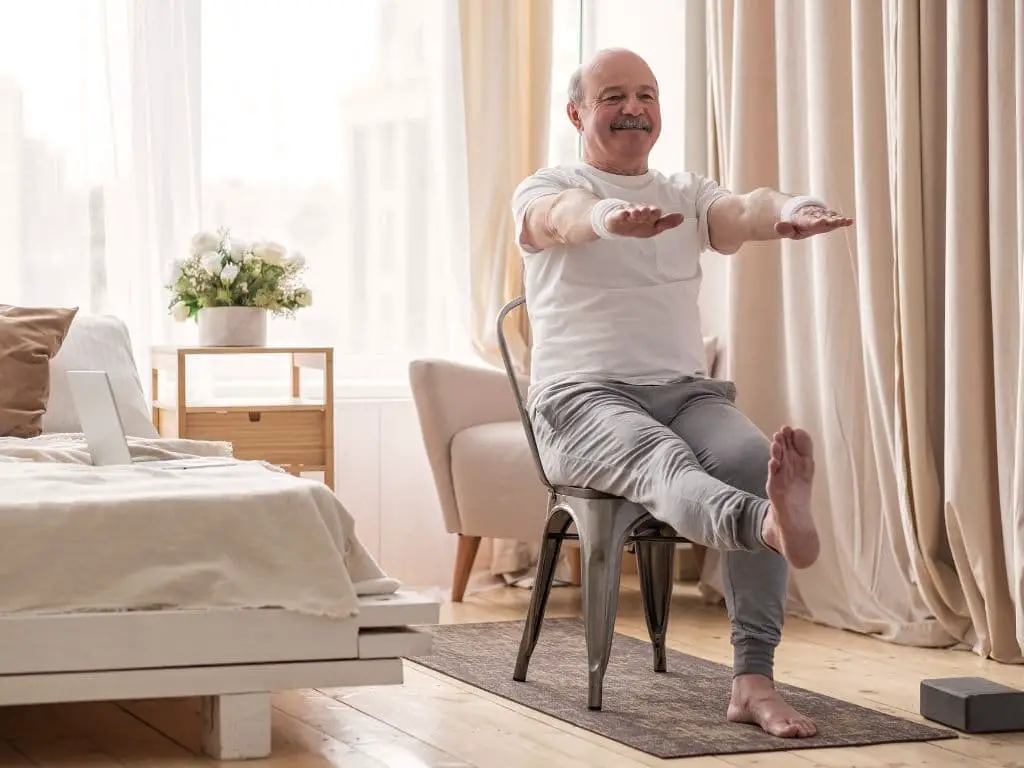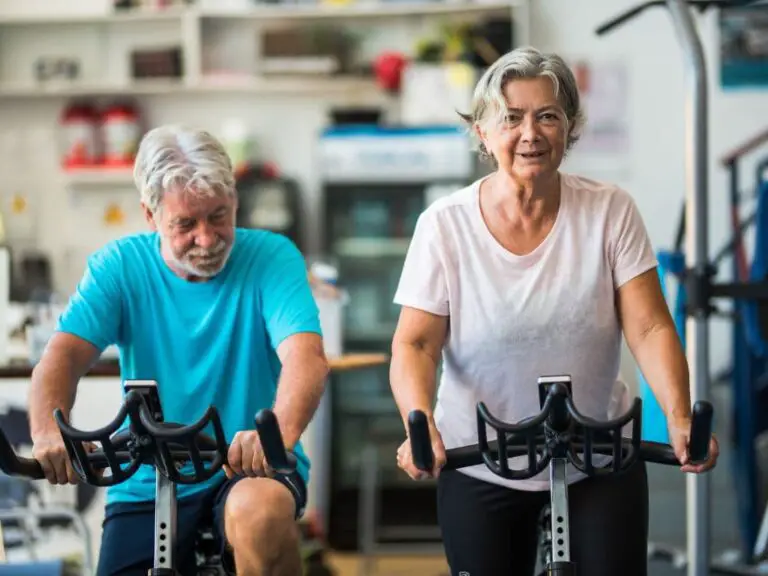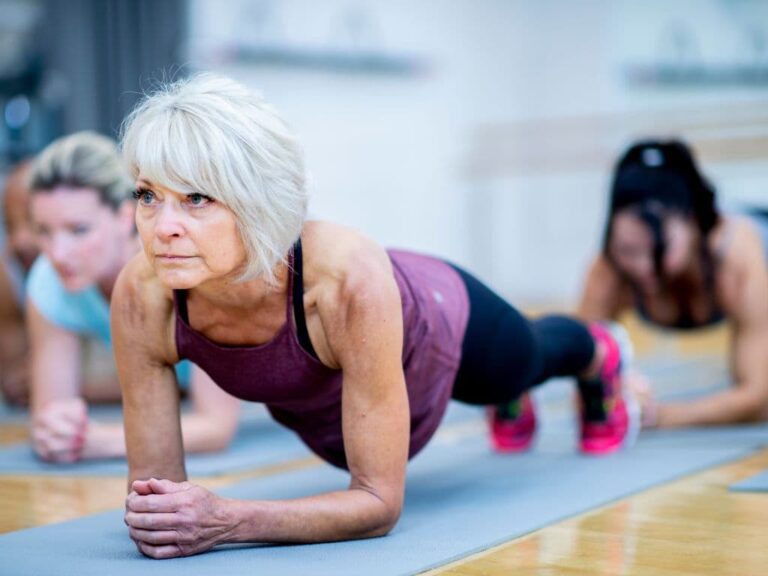Do Home Workouts Work for Seniors?
Regular physical activity is crucial for seniors to maintain their health, independence, and overall well-being. Home workouts can be an accessible, safe, and effective way for seniors to exercise.
But, do home workouts work?
Yes, home workouts can be highly effective for seniors. Regular physical activity, such as walking, chair exercises, yoga, tai chi, and Pilates can improve heart health, lower the risk of chronic conditions, enhance cognitive function, reduce stress and anxiety, boost energy levels and promote healthy aging. It’s recommended that seniors engage in moderate exercise for 150 minutes per week. However, high-impact activities should be avoided to prevent injuries.
The benefits of exercising at home for seniors are extensive, covering physical health, mental health, and more. With some planning and guidance, seniors can develop a sustainable home workout routine that enhances their quality of life.

What are the Benefits of Home Workouts for Seniors?
Physical activity provides a range of health benefits for seniors. A regular exercise routine can help seniors improve and preserve key aspects of health as they age. Home workouts are a convenient way to be active without the need to go to a gym or fitness center.
How Can Exercise Improve Health and Well-being in Seniors?
Experts recommend regular exercise for seniors because physical activity has been shown to:
- Improve heart health by reducing blood pressure, cholesterol, and triglyceride levels
- Lower the risk of developing chronic conditions like diabetes, heart disease, obesity, and some cancers
- Prevent falls and injuries by building muscle strength and balance
- Enhance cognitive function by increasing blood flow and oxygen to the brain
- Reduce stress and anxiety by releasing endorphins and improving mood
- Boost energy levels and fight fatigue by improving sleep quality
- Promote healthy aging by preventing muscle loss and strengthening bones
Overall, consistent exercise strengthens the body and keeps seniors active and independent as they age.
How Does Physical Activity Enhance Mobility, Balance, Strength, Flexibility, and Endurance in Seniors?
Regular exercise helps seniors maintain and improve key physical attributes including:
- Mobility: Staying active preserves joint flexibility and range of motion. This makes everyday tasks like walking, bending, and climbing stairs easier.
- Balance: Exercises that challenge balance aid stability and prevent falls. Strength training also plays a key role in balance.
- Strength: Resistance exercises build muscle mass and strength. This makes daily activities less tiring and reduces injury risk.
- Flexibility: Stretching, yoga, and other full-range of motion exercises enhance flexibility. This allows for greater mobility and reduced muscle soreness.
- Endurance: Aerobic activity like walking, cycling, or swimming boosts cardiovascular endurance. This reduces fatigue and breathlessness during everyday tasks.
Targeting these areas through home workouts allows seniors to perform daily activities and live independently for longer.
What are Some Safe and Effective Home Workouts for Seniors?
Seniors can choose from various types of low-impact exercises to create a well-rounded fitness routine from home. Recommended home workout options include:
What Low-Impact Exercises are Suitable for Seniors?
- Walking – Taking daily walks is an easy aerobic workout seniors can do without stressing joints.
- Water aerobics – Water offers cushioning and gentle resistance for a safe cardio workout.
- Chair exercises – Seated routines allow seniors to exercise with support and balance.
- Yoga – Gentle forms like hatha yoga improve strength, balance, and flexibility.
- Tai chi – These flowing movements enhance mobility, breathing, and stability.
How Can Chair Exercises Benefit Seniors?
Chair-based workouts are a low-impact way for seniors to exercise safely. Chair exercises work various muscle groups while providing stability. Example chair exercises include:
- Seated marching to engage legs and core
- Arm raises to strengthen upper body
- Ankle flexes and points to increase mobility
- Seated yoga poses like twists and folds to build flexibility
Chair workouts activate muscles, improve range of motion, and prevent muscle atrophy from inactivity. They require minimal space and can be done while watching TV.
Why Should Seniors Consider Water Aerobics?
Water offers an ideal environment for seniors to exercise gently. Benefits of water aerobics include:
- The water supports body weight to reduce strain on joints and muscles
- Water resistance tones the body while keeping intensity low
- Exercising in water improves cardiovascular fitness with less impact
- The natural buoyancy aids balance training by challenging stability
- Water aerobics classes provide social interaction to enhance mental health
Water workouts allow seniors to improve holistic fitness safely. Classes are widely available at most gyms and community pools.
How Can Yoga Improve Senior Fitness?
Yoga is a versatile form of exercise combining poses, stretches, and breathing. A gentle yoga practice provides these wellness benefits for seniors:
- Yoga poses build strength, balance, and flexibility through full range of motion.
- Controlled breathing fosters mental clarity and stress relief.
- Meditation and mindfulness elements reduce anxiety and depression.
- Classes offer community connection and accountability.
- Yoga requires minimal equipment and can be done from home.
Modified yoga with props or chair support makes yoga accessible for seniors at all fitness levels.
Why is Tai Chi Recommended for Seniors?
Tai chi is an excellent choice to enhance senior fitness at home due to its emphasis on:
- Gentle, flowing movements that improve balance, coordination, strength, and flexibility
- Deep breathing and meditation that calm the mind and reduce stress
- Low-impact exercise that is easy on joints
- Increased focus and concentration that may delay cognitive decline
- Social interaction in group classes that provides mental stimulation
Tai chi promotes holistic wellness without strain or injury risk. Seniors can start with short sessions from home and progress over time.
How Can Pilates Contribute to Senior Fitness?
Pilates focuses on strengthening core muscles that provide stability and support. Key advantages of Pilates for seniors include:
- Targeted exercises strengthen abdominal and back muscles that aid balance and posture.
- Controlled movements improve joint flexibility and range of motion.
- Conscious breathing enhances mind-body awareness and stress management.
- Classes offer community connection and socialization.
- Pilates requires little equipment and can be done from a chair or mat.
A modified Pilates routine helps seniors maintain core strength and coordination.
How Often Should Seniors Exercise at Home?
Experts recommend seniors engage in moderate exercise for 150 minutes per week, which equates to 30 minutes per day for 5 days a week. Aerobic, strength training, flexibility, and balance exercises should all be incorporated.
What is the Recommended Frequency of Exercise for Seniors?
A balanced exercise routine spread out over the week is ideal. Guidelines suggest seniors aim for:
- Aerobic activity: Get moving every day with activities like walking, swimming, or cycling. Start with 10 minute sessions and build up.
- Strength training: Do resistance exercises targeting major muscle groups 2-3 days per week. Allow a day of rest in between sessions.
- Flexibility: Daily gentle stretches keep muscles limber. Yoga and Pilates sessions 2-3 times a week enhance mobility.
- Balance: Balance exercises should be done 3-4 days per week to hone stability and prevent falls.
Consistency is key – even short bursts of activity each day provide benefits. Seniors who are new to exercise should consult their doctor and start slowly.
For How Long Should Seniors Exercise Each Time They Workout at Home?
When beginning a home exercise routine, seniors should start with shorter workouts and gradually increase the duration over time as fitness improves.
What is the Ideal Duration of Each Workout Session for a Senior?
For seniors new to exercise, aim for:
- 10-15 minutes of flexibility and balance training daily
- 10 minutes of cardio activity like walking or cycling daily
- 10-15 minutes of strength training every other day
Then, build up duration to work towards expert recommendations:
- Aerobic activity: Work towards at least 30 minutes of moderate cardio exercise most days of the week. This raises the heart rate and promotes endurance.
- Strength training: Build up to 30-60 minute sessions 2-3 times per week for full body strength. Allow at least 1 day of rest between sessions.
- Flexibility: Daily stretching sessions of 10-15 minutes promote range of motion. Build yoga and Pilates sessions up to 30-45 minutes.
Starting with brief sessions prevents overexertion and allows seniors to learn proper technique. Workout duration can then increase along with fitness.
Are There Any Exercises That Should be Avoided by Seniors During Their Home Workouts?
While exercise is beneficial, seniors should modify or avoid certain high-impact activities. Exercising safely helps prevent injuries.
High-impact exercises involve a lot of force going through the joints, often including jumping or running. While these activities are fine for younger adults, seniors need to be more careful to avoid injury or strain. Some specific high-impact exercises that seniors should generally avoid or modify include:
Jogging or running can put a lot of stress on hip, knee, and ankle joints if not done properly. For seniors new to exercising, brisk walking at an incline is a safer alternative that elevates heart rate without the joint impact. If jogging is desired, seniors should build up very gradually from short intervals of slow jogging mixed with walking. Running long distances or sprinting is not recommended. A stationary bike can provide a cardio workout without pounding the joints.
Jumping exercises like jumping jacks, box jumps, or plyometrics involve explosive leaping that jars the joints upon landing. These should be avoided altogether by seniors in favor of low-impact cardio alternatives. Ground-based exercises like squats or lunges are gentler on the knees and hips.
High-impact aerobics or dance classes marked by leaping, hopping, and jumping are risky for those with joint issues or balance concerns. Low-impact dance styles like ballroom dancing provide cardiovascular benefits for seniors without the joint strain.
Sports like basketball, tennis, hockey, and soccer require sprinting and rapid changes in direction that can stress joints and lead to falls. Gentler sports like golf, swimming, or bowling are safer active lifestyle options.
Listening to the body’s feedback and avoiding discomfort or pain with any exercise is important at any age. For seniors especially, staying active in a low-impact, controlled way is key to gaining the multitude of exercise benefits while preventing unnecessary injury. A bit of joint soreness is expected when starting a new routine, but sharp joint pain is a sign to stop and reassess the workout approach. With some sensible modifications, seniors can craft home workouts that strengthen the body for better function and quality of life.
What Precautions Should Be Taken When Exercising at Home as a Senior?
Seniors should use caution with:
- High-impact aerobics: Activities like jogging and jumping put excessive strain on joints. Low-impact cardio like walking or swimming are safer alternatives.
- Heavy weight training: Lifting heavy weights increases injury risk. Lighter resistance training produces benefits without the strain.
- Twisting movements: Quick trunk and spinal twists can cause back injury. Simple back stretches are a better option.
- Exercise that aggravates existing conditions: Skip activities that worsen joint pain, back issues, or balance problems.
Seniors should also watch out for dizziness, extreme shortness of breath, and chest or muscle pain during exercise. Stopping activity promptly and consulting a doctor if such symptoms occur reduces health risks.
How Can Seniors Stay Motivated to Continue with Their Home Workouts?
Staying motivated to exercise consistently can be a challenge at any age. Useful strategies to help seniors maintain their home workout routines include:
What Strategies can Help Maintain Consistency in Senior’s Exercise Routine?
- Set specific goals like walking a certain distance or doing a certain number of reps. Achievable goals provide a sense of purpose.
- Keep a fitness journal to track progress. Seeing improvement is motivating.
- Exercise with a partner for accountability and camaraderie.
- Incorporate variety by switching up aerobic, strength, and flexibility activities. Prevent boredom.
- Focus on long-term health benefits like remaining independent rather than aesthetic or fitness goals. Better health is the key payoff.
- Make exercise a habit by putting it on the calendar and exercising at the same time each day. Habits are easier to maintain.
- Reward progress by celebrating fitness milestones. Reinforcement encourages more activity.
Simple lifestyle changes can help seniors stick with their routine and continue reaping the benefits of home workouts.
Where Can One Find Resources on Effective and Safe Home Workouts for Seniors?
Many resources provide guidance on creating home exercise programs tailored to seniors’ needs. Excellent sources of home workout tips for seniors include:
Which Online Platforms Provide Reliable Information on Senior’s Home Workouts?
- Government health sites like the NIH National Institute on Aging and CDC Healthy Aging
- Nonprofit organizations like the American Association of Retired Persons (AARP)
- Medical center sites like Johns Hopkins and the Mayo Clinic
- Senior health publications like Silverts and Sixty and Me
- Online video channels on platforms like YouTube demonstrating senior fitness
- Senior blogs featuring home workout tips
Seniors should consult their physician before starting any new exercise program. With guidance, a home workout routine can safely provide major benefits for seniors’ physical and mental health. Consistency, proper form, and listening to one’s body are key for sustainable fitness gains.
Frequently Asked Questions
-
Do Walk at Home workouts work?
You can walk around the house if you just want to get more movement. Moderate-intensity exercises are recommended if you want to improve your overall health. To achieve this goal, you may have to increase the intensity of your walk.
-
Do workout DVDs really work?
Although there is not much research on the effectiveness of exercise DVDs in keeping you fit, one study showed that women who exercised with instructors wearing revealing clothing that highlighted her toned and thin bodies felt less confident.
-
Are indoor walking exercises effective?
John Thornhill, Aaptiv’s master trainer, says that walking is an excellent cardio exercise. However, it can also be heart-racing and high-intensity exercise if done correctly. We’ve collected some of our favourite videos to keep indoor walking interesting.
-
Is 70 years old considered old?
One American researcher discovered that the age at which you can be considered old is 70-71 for men, and 73-73 for women. In Britain, old age began at the age of 59 just a little over ten years ago. Research done in 2018 revealed that 70-year-olds were believed to be old by British citizens.
-
Do exercise videos work?
The best thing about exercise videos is that you can do it at your home. Although working out in a gym can be a good way to stay fit, it isn’t for everybody.
-
What is the best exercise for a 75 year old woman?
Chair yoga, like water aerobics is low-impact exercise. It improves flexibility, muscle strength and mobility. The accessible version of chair yoga puts less strain on the joints and muscles than other forms of yoga.
-
What is the best exercise DVD for beginners?
The Best DVD for Beginners is Get Fit Daily Dozen. It contains five 12 minute routines, each with a new exercise every minute. These 12 minute exercises are quick and easy to incorporate into your busy life. They can also be used individually for endurance building, or together as a whole-body workout once you’re stronger.
-
Is working out 30 minutes a day enough to lose weight?
Aim for 30 minutes of moderate exercise each day as a goal. You may have to be more active if you are looking to lose weight, keep your weight down, or reach specific fitness goals. It is also important to reduce your sitting time. Your risk for metabolic issues is higher the more time you spend sitting each day.
-
Are there any exercise channels on TV?
You can select from channels offering yoga, interval training, resistance training or stretching. Gaiam TV Fit and Yoga and Grokker Yoga Fitness are three of their favorite channels.
-
Is there a free exercise Channel?
Both men and women can subscribe to the MrandMrsMuscle YouTube Channel. Two personal trainers can help you get a great workout at home in as little as 15 minutes.






